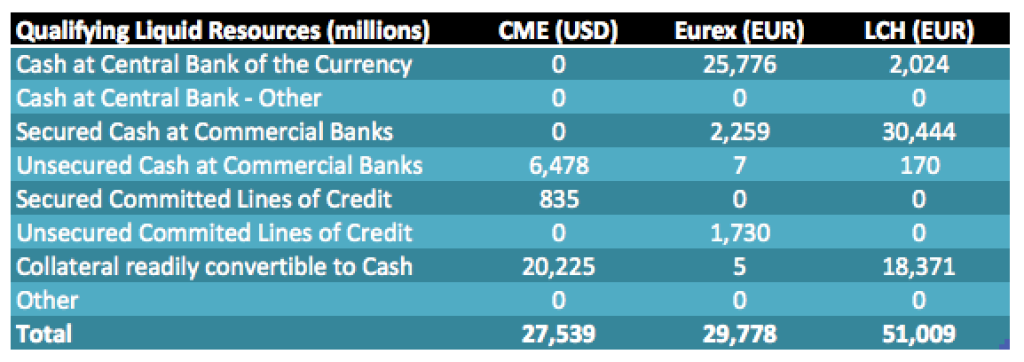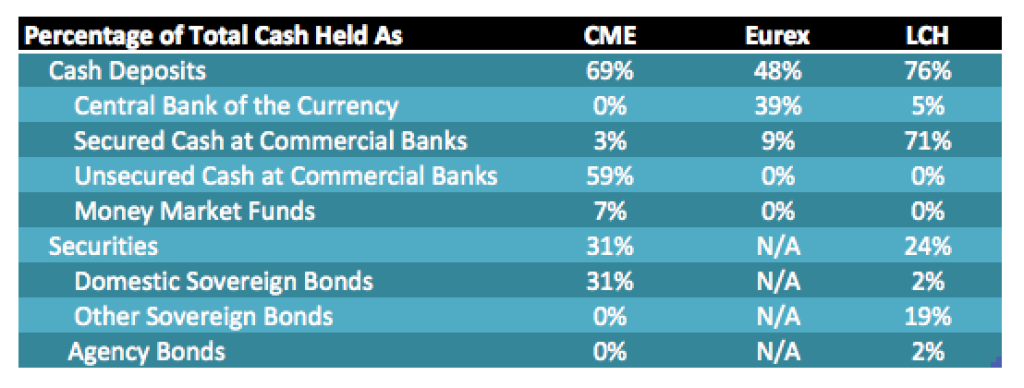A lot has been written about the increasing systemic importance of Derivatives Clearing Houses, so I thought it would be interesting to see what the new CCP Quantitative Disclosures show on how cash is held by CCPs and the differences in practice between them.
As the relevant disclosures are generally at a Clearing House level and not at Clearing Service level, I will look at disclosures for CME, Eurex Clearing and LCH Clearnet Ltd as the three largest CCPs for Interest Rates across Futures and Options (ETD) and Swaps (OTC) products.
Liquidity Risk
The Liquidity Risk (7.1) disclosures quantify the size and composition of qualifying liquid resources.
Showing that:
- CME has $27.5 billion of Qualifying Liquid Resources of which $6.4b is Unsecured Cash at Commercial Banks and $20.2b is Collateral readily convertible to cash
- Eurex has €29.8 billion of Qualifying Liquid Resources of which €25.8b is Cash at Central Bank (both EUR & CHF), €2.2b is Secured Cash at Commercial Banks and €1.7b is Unsecured Committed Lines of Credit
- LCH Ltd has €51 billion of Qualifying Liquid Resources of which €2b is Cash at Central Bank, €30.4b is Secured Cash at Commercial Banks and €18.4b is Collateral readily convertible to cash
Interesting differences in the composition at each Clearing House:
- CME holds 73% in Collateral readily convertible to cash and 24% in Unsecured Cash at Commercial Banks
- Eurex holds 87% in Central Banks (ECB and SNB)
- LCH Ltd holds 60% in Secured Cash at Commercial Banks and 36% in Collateral readily convertible to cash
Presumably the secured cash in question is primarily reverse repo agreements.
Total Cash Received
Total Cash Received from Participants (16.1) Disclosures are also interesting to compare.
Converting all amounts to USD, using EUR/USD as 1.1 and GBP/USD as 1.5, we can see the cash received from market participants and held at each Clearing House, split by Initial Margin and Default Fund contributions.
How Total Cash Received is Held
How Total Cash Received is Held (16.2) Disclosures show how these amounts are held/deposited/invested.
Showing:
- CME holds 69% in Cash Deposits and 31% in Government Securities
- CME holds 59% in Unsecured Cash at Commercial Banks and 7% in Money market funds
- Eurex holds 48% in Cash Deposits (EUR) while Securities are specified as N/A (as not on the Balance Sheet)
- Eurex holds most of this cash at Central Banks
- LCH holds 76% in Cash Deposits and 24% in Government Securities
- LCH holds 71% in Secured Cash at Commercial Banks and 5% in Central Banks
- LCH holds 2% in GB Sovereigns, 19% in US and EU Sovereigns and 2% in Agencies
This shows significant differences in managing cash:
- CME has its largest proportion in Unsecured Cash at Commercial Banks (Systematically Important ones)
- Eurex has its largest proportion in Central Banks (ECB, SNB)
- LCH has its its largest proportion in Secured cash at Commercial Banks (presumably reverse repo)
Thats it for the detail.
Final Thoughts
CCP Disclosures shed new light on the cash held by Clearing Houses.
These show the large amounts of cash held, tens of billions of dollars.
CCP Disclosures shed new light on how this cash is held.
Practices differ significantly between the three Clearing Houses we looked at.
A different mix of Cash at Central Banks, Commercial Banks (Secured or Unsecured) and Sovereign Bonds.
Down to the policies, preferences and available resources for a Clearing House.
Pros and Cons of each is a large topic and one for another day.




Given a CCP’s “investment policy” is driven by the regulations, not really ‘CCP preferences’, there is clearly a surprisingly disparate gap between DFA and EMIR?